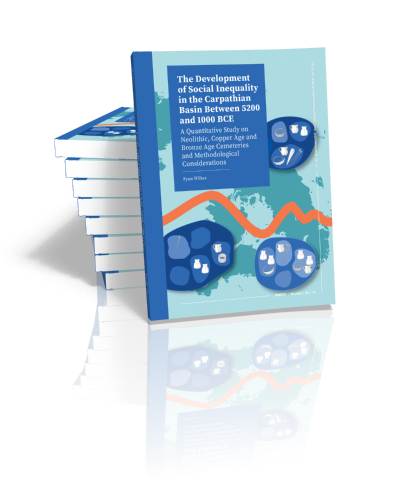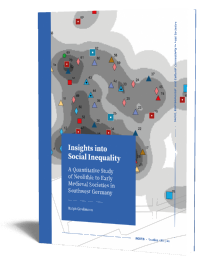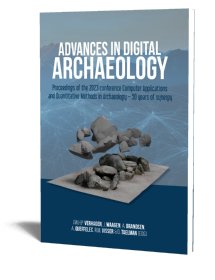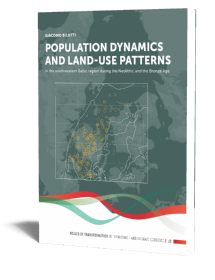The Development of Social Inequality in the Carpathian Basin between 5200 and 1000 BCE
A Quantitative Study on Neolithic, Copper Age and Bronze Age Cemeteries and Methodological Considerations
Fynn Wilkes | Forthcoming

The Development of Social Inequality in the Carpathian Basin between 5200 and 1000 BCE
A Quantitative Study on Neolithic, Copper Age and Bronze Age Cemeteries and Methodological Considerations
Fynn Wilkes | Forthcoming
Paperback ISBN: 9789464281170 | Hardback ISBN: 9789464281187 | Imprint: Sidestone Press Dissertations | Format: 210x280mm | ca. 200 pp. | ROOTS Studies 11 | Series: ROOTS Studies | Language: English | 2 illus. (bw) | 37 illus. (fc) | Keywords: archaeology; social differentiation; prehistory; burials; Gini index; generalized entropy measure; Carpathian Basin; Neolithic; Chalcolithic; Bronze Age | download cover | DOI: 10.59641/kk545nw | CC-license: CC BY 4.0
Publication date: 25-03-2026
-
Digital & Online access
Digital/Online version not (yet) available
-
Buy via Sidestone (EU & UK)
Get €5.00 discount on forthcoming books by using coupon code "PRE-ORDER" in your shopping cart!
-
Buy via our Distributors (WORLD)
For non-EU or UK destinations you can buy our books via our international distributors. Although prices may vary this will ensure speedy delivery and reduction in shipping costs or import tax. But you can also order with us directly via the module above.
For UK & other International destinations
For USA/Canada & other International destinations
-
Bookinfo
Paperback ISBN: 9789464281170 | Hardback ISBN: 9789464281187 | Imprint: Sidestone Press Dissertations | Format: 210x280mm | ca. 200 pp. | ROOTS Studies 11 | Series: ROOTS Studies | Language: English | 2 illus. (bw) | 37 illus. (fc) | Keywords: archaeology; social differentiation; prehistory; burials; Gini index; generalized entropy measure; Carpathian Basin; Neolithic; Chalcolithic; Bronze Age | download cover | DOI: 10.59641/kk545nw | CC-license: CC BY 4.0
Publication date: 25-03-2026

We will plant a tree for each order containing a paperback or hardback book via OneTreePlanted.org.
This dissertation investigates the dynamics of social inequality in the Carpathian Basin between the Late Neolithic and the Middle/Late Bronze Age (5200–1000 BCE) through a quantitative analysis of burial contexts. Employing statistical methods, including Gini indices and Generalized Entropy Measures, the study evaluates the extent, development, and underlying factors of inequality within prehistoric societies.
Key findings reveal a complex, cyclical pattern of inequality, challenging the notion of linear progression. While the overall mean levels of inequality show no consistent long-term increase or decrease, a significant broadening of inequality ranges is evident. This suggests increased societal diversification, with some communities maintaining egalitarian structures while others exhibited pronounced stratification. The research highlights that these disparities were likely driven by factors such as societal size, technological advancements, resource distribution, and cultural practices. A focused examination of wealth-based societal segments uncovers divergent trends: A slight equalisation among less wealthy societal segments contrasts with a marked concentration of wealth within wealthy groups.
This work underscores the interplay of social, cultural, and material developments in shaping prehistoric inequality, providing a foundational framework for further exploration into the dynamics of past societies.
Foreword of the series editors
Acknowledgements
Chapter 1: Introduction
1.1 Definition of social inequality
1.2 Emergence and persistence of inequality
1.3 Social inequality in the prehistory of Europe and the Carpathian Basin
Chapter 2: The environmental and archaeological setting
2.1 The natural environment and climate history
2.2 Chronology and archaeological cultures
2.2.1 Cultural groups of the Neolithic
2.2.2 The cultural groups of the Copper Age
2.2.3 The cultural groups of the Bronze Age
2.2.3.1 Great Pannonian Plain and Transdanubia
2.3.3.2 Little Pannonian Plain
Chapter 3: Data
3.1 Data selection
3.2 Data acquisition and database
3.2.1 Cemetery/Site
3.2.2 Grave
3.2.2.1 Grave dimension
3.2.2.2 Cemetery phases
3.2.3 Burial
3.2.3.1 Degree of Disturbance
3.2.3.2 Anthropological sex and age
3.2.4 Inventory
3.2.5 Isotopes
Chapter 4: Methodology
4.1 Structure of the analysis
4.2 Assumptions
4.3 Methods of the analyses
4.3.1 Object classes
4.3.2 Social index
4.3.3 Segments of society
4.3.3.1 Giniall index
4.3.3.2 Ginilow index
4.3.3.3 Giniupper and Shareupper
4.3.4 Gini index and Lorenz curve
4.3.5 Generalized Entropy Measures
4.3.6 Standard errors and confidence intervals of the Gini index
4.3.7 Correlation coefficients
4.3.8 Descriptive analysis
4.3.8.1 Linear trend
4.3.8.2 LOESS regression
4.3.8.3 Boxplots
4.3.9 Significance testing
4.3.9.1 Comparison of median inequality measures between time groups and single sites
4.3.9.2 Variance in inequality measures between time groups
4.3.10 Chronological determinations
4.3.11 Effect and sample size
4.3.12 Analysis of quantity of grave goods, site size, material types, functional object groups and social inequality
Chapter 5: Results and implications of the analysis
5.1 Measures of inequality: Statistical characteristics, correlations and limitations
5.1.1 General presentation of the individual Gini indices
5.2 General presentation of the individual Generalized Entropy Measures and the Shareupper
5.3 Correlations of the applied inequality measures
5.4 Boundaries of the analysis: Statistical significance, effect size and sample size
5.5 Trends in the development of inequality: Linear regression analysis
5.6 Trends in the development of inequality: The range of inequality measures
5.7 Temporal dynamics of inequality: LOESS regression analysis
5.7.1 First Meander: from 5200 to 3750 BCE
5.7.2 Second Meander: from 2100 to 1000 BCE
5.8 Inequality, social index and the quantity of grave goods
5.9 Distribution of the social index
5.10 Site size and inequality
5.11 Technology, resource access and inequality
5.11.1 Excursus: Craftsmen, warrior or hunter graves
Chapter 6: Discussion
6.1 A development of social inequality?
6.2 A growing range of social inequalities
6.3 Methodological issues: Sample sizes
Chapter 7: Conclusion and Outlook
7.1 Analysing the development of social inequality
7.2 Investigating the development of wealth-based segments
7.3 Contributing to methodological development
7.4 Discussing observations in relation to economic, environmental, and social processes
Summary
Summary in German
References
Appendices
Appendix A: Cemetery/Site catalogue
Appendix B: Object classes
Appendix C: Results of the significance tests
Results of the Wilcoxon test between three chronological groups
Results of the Levene test between three chronological groups
R-Codes
Appendix D: Maps
Appendix E: Lorenz curves
Database and Supplements (online)
Dr. Fynn Wilkes
Fynn Wilkes is an archaeologist specializing in social, economic, and settlement archaeology, with a focus on the prehistory of Central and South-eastern Europe. After earning his Master’s degree in Pre- and Protohistory and Geography from Kiel University in 2019, he joined the ROOTS Young Academy at Kiel University, completing his PhD in 2024. His research is focused around social, economic and settlement archaeology in the prehistory of Central and South-Eastern Europe. Currently, he conducts fieldwork on multiple Neolithic sites in the Southern Carpathian Basin.
Abstract:
This dissertation investigates the dynamics of social inequality in the Carpathian Basin between the Late Neolithic and the Middle/Late Bronze Age (5200–1000 BCE) through a quantitative analysis of burial contexts. Employing statistical methods, including Gini indices and Generalized Entropy Measures, the study evaluates the extent, development, and underlying factors of inequality within prehistoric societies.
Key findings reveal a complex, cyclical pattern of inequality, challenging the notion of linear progression. While the overall mean levels of inequality show no consistent long-term increase or decrease, a significant broadening of inequality ranges is evident. This suggests increased societal diversification, with some communities maintaining egalitarian structures while others exhibited pronounced stratification. The research highlights that these disparities were likely driven by factors such as societal size, technological advancements, resource distribution, and cultural practices. A focused examination of wealth-based societal segments uncovers divergent trends: A slight equalisation among less wealthy societal segments contrasts with a marked concentration of wealth within wealthy groups.
This work underscores the interplay of social, cultural, and material developments in shaping prehistoric inequality, providing a foundational framework for further exploration into the dynamics of past societies.
Contents
Foreword of the series editors
Acknowledgements
Chapter 1: Introduction
1.1 Definition of social inequality
1.2 Emergence and persistence of inequality
1.3 Social inequality in the prehistory of Europe and the Carpathian Basin
Chapter 2: The environmental and archaeological setting
2.1 The natural environment and climate history
2.2 Chronology and archaeological cultures
2.2.1 Cultural groups of the Neolithic
2.2.2 The cultural groups of the Copper Age
2.2.3 The cultural groups of the Bronze Age
2.2.3.1 Great Pannonian Plain and Transdanubia
2.3.3.2 Little Pannonian Plain
Chapter 3: Data
3.1 Data selection
3.2 Data acquisition and database
3.2.1 Cemetery/Site
3.2.2 Grave
3.2.2.1 Grave dimension
3.2.2.2 Cemetery phases
3.2.3 Burial
3.2.3.1 Degree of Disturbance
3.2.3.2 Anthropological sex and age
3.2.4 Inventory
3.2.5 Isotopes
Chapter 4: Methodology
4.1 Structure of the analysis
4.2 Assumptions
4.3 Methods of the analyses
4.3.1 Object classes
4.3.2 Social index
4.3.3 Segments of society
4.3.3.1 Giniall index
4.3.3.2 Ginilow index
4.3.3.3 Giniupper and Shareupper
4.3.4 Gini index and Lorenz curve
4.3.5 Generalized Entropy Measures
4.3.6 Standard errors and confidence intervals of the Gini index
4.3.7 Correlation coefficients
4.3.8 Descriptive analysis
4.3.8.1 Linear trend
4.3.8.2 LOESS regression
4.3.8.3 Boxplots
4.3.9 Significance testing
4.3.9.1 Comparison of median inequality measures between time groups and single sites
4.3.9.2 Variance in inequality measures between time groups
4.3.10 Chronological determinations
4.3.11 Effect and sample size
4.3.12 Analysis of quantity of grave goods, site size, material types, functional object groups and social inequality
Chapter 5: Results and implications of the analysis
5.1 Measures of inequality: Statistical characteristics, correlations and limitations
5.1.1 General presentation of the individual Gini indices
5.2 General presentation of the individual Generalized Entropy Measures and the Shareupper
5.3 Correlations of the applied inequality measures
5.4 Boundaries of the analysis: Statistical significance, effect size and sample size
5.5 Trends in the development of inequality: Linear regression analysis
5.6 Trends in the development of inequality: The range of inequality measures
5.7 Temporal dynamics of inequality: LOESS regression analysis
5.7.1 First Meander: from 5200 to 3750 BCE
5.7.2 Second Meander: from 2100 to 1000 BCE
5.8 Inequality, social index and the quantity of grave goods
5.9 Distribution of the social index
5.10 Site size and inequality
5.11 Technology, resource access and inequality
5.11.1 Excursus: Craftsmen, warrior or hunter graves
Chapter 6: Discussion
6.1 A development of social inequality?
6.2 A growing range of social inequalities
6.3 Methodological issues: Sample sizes
Chapter 7: Conclusion and Outlook
7.1 Analysing the development of social inequality
7.2 Investigating the development of wealth-based segments
7.3 Contributing to methodological development
7.4 Discussing observations in relation to economic, environmental, and social processes
Summary
Summary in German
References
Appendices
Appendix A: Cemetery/Site catalogue
Appendix B: Object classes
Appendix C: Results of the significance tests
Results of the Wilcoxon test between three chronological groups
Results of the Levene test between three chronological groups
R-Codes
Appendix D: Maps
Appendix E: Lorenz curves
Database and Supplements (online)
Dr. Fynn Wilkes
Fynn Wilkes is an archaeologist specializing in social, economic, and settlement archaeology, with a focus on the prehistory of Central and South-eastern Europe. After earning his Master’s degree in Pre- and Protohistory and Geography from Kiel University in 2019, he joined the ROOTS Young Academy at Kiel University, completing his PhD in 2024. His research is focused around social, economic and settlement archaeology in the prehistory of Central and South-Eastern Europe. Currently, he conducts fieldwork on multiple Neolithic sites in the Southern Carpathian Basin.
-
Digital & Online access
Digital/Online version not (yet) available
-
Buy via Sidestone (EU & UK)
Get €5.00 discount on forthcoming books by using coupon code "PRE-ORDER" in your shopping cart!
-
Buy via our Distributors (WORLD)
For non-EU or UK destinations you can buy our books via our international distributors. Although prices may vary this will ensure speedy delivery and reduction in shipping costs or import tax. But you can also order with us directly via the module above.
For UK & other International destinations
For USA/Canada & other International destinations
- Browse all books by subject
-
Search all books

We will plant a tree for each order containing a paperback or hardback book via OneTreePlanted.org.
You might also like:
© 2025 Sidestone Press KvK nr. 28114891 Privacy policy Sidestone Newsletter Terms and Conditions (Dutch)








